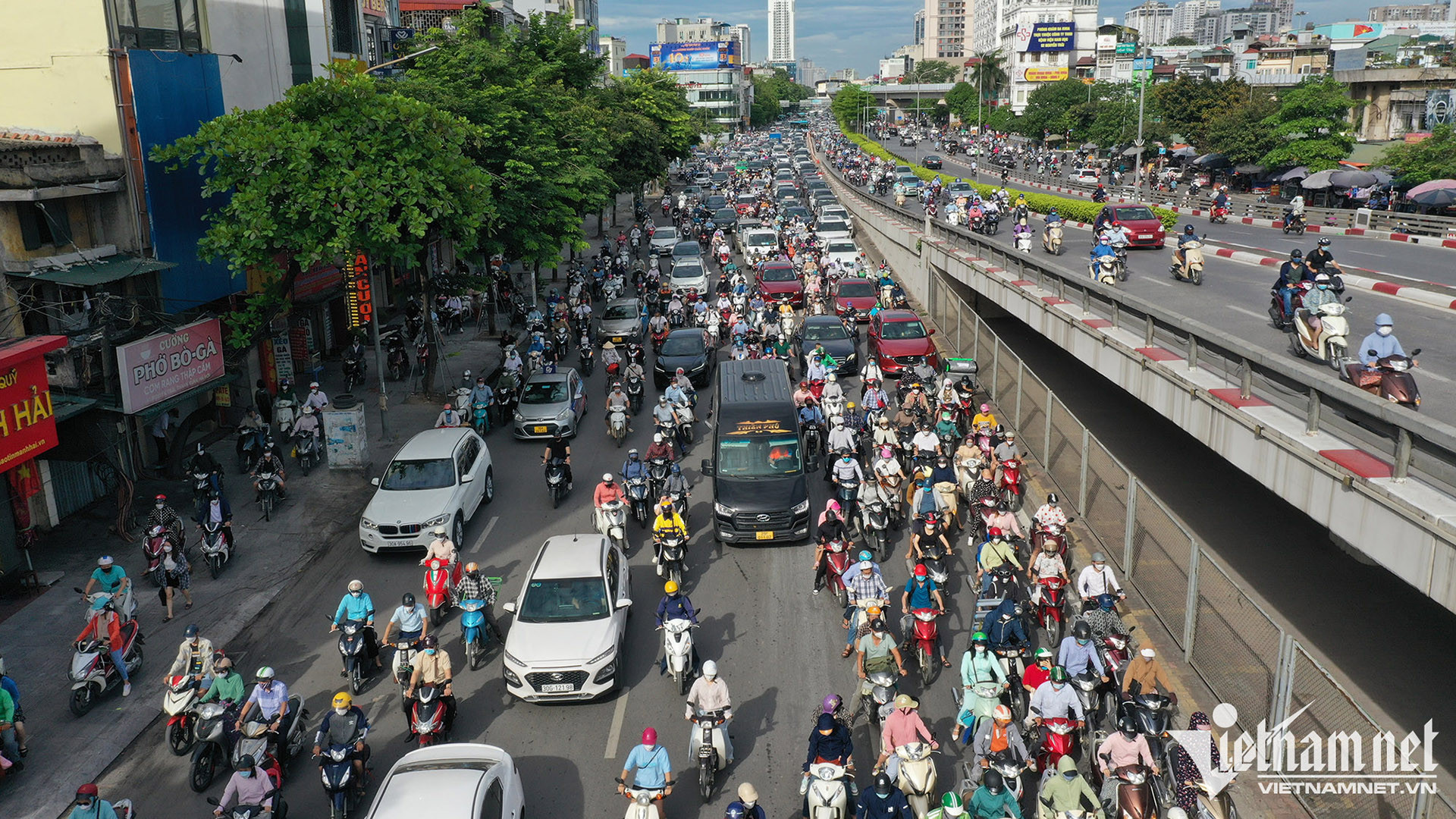There are times when stepping outside means walking into a haze of pollution, and commuting becomes a gamble with one’s health.
Air pollution has its seasons - and its peak hours

Air pollution has long plagued Vietnam’s major urban centers, particularly its two economic powerhouses: Hanoi and Ho Chi Minh City.
Research indicates pollution follows a seasonal pattern - typically from October or November through March or April - and is concentrated in areas with high traffic and industrial activity. Within a day, air quality tends to be worst during peak commuting hours: 6–8 a.m. and 5–7 p.m.
Tran Bao Ngoc, a resident of Vinh Ngoc commune, Dong Anh district, Hanoi, shared, “During the pollution season, I commute by motorbike to the city center and feel the thick, choking smog in my nose - even with a mask. From Nhat Tan Bridge, the entire city looks shrouded in a dust fog. Every day, I drive through that haze to work, worrying about its impact on my health.”
Ngoc’s concerns echo those of many living in polluted zones. Studies in Hanoi and Ho Chi Minh City reveal that air pollution is primarily driven by particulate matter (TSP, PM10, PM2.5) and gases such as CO, NO2, SO2, and Pb.
By late 2024 and early 2025, Hanoi frequently recorded “very poor” Air Quality Index (AQI) readings - posing severe health risks, especially to the elderly, children, and people with respiratory conditions. Seasonal fog and cold air trap pollutants near the ground, making the pollution more palpable.
Targeting the sources of pollution
According to the Department of Environment (Ministry of Agriculture and Environment), urban air pollution - particularly PM2.5 - stems mainly from traffic emissions, accounting for 40–60% of the total.
Emission control in transportation involves two approaches: regulating vehicle exhaust standards and controlling fuel quality. Vietnam has made progress by banning leaded gasoline to reduce Pb, and sulfur content limits to curb SO2. PM, HC, NOx, and CO emissions are addressed through legal exhaust standards for motor vehicles.
Key regulations have long been in place. In 2005, the Prime Minister approved a roadmap for applying vehicle emissions standards. In 2011, standards were extended to newly manufactured or imported motorbikes and cars.
By June 2016, the National Action Plan on Air Quality Management (vision to 2025) was introduced, mandating stricter control of transportation emissions and the establishment of national technical standards.
In March 2019, a roadmap was issued for applying emissions standards to used and imported cars, followed by updated regulations in November 2024. These standards are based on TCVN 6438 (maximum allowable emissions for road vehicles) and aligned with international Euro levels.
For motorbikes, while a formal roadmap is still pending, the Ministry of Transport requires emissions testing for bikes in use for over five years.
To prevent disruptions, emission control policies are designed to be gradual, integrating electric vehicles and public transport as sustainable alternatives.
With the Environmental Protection Law passed in 2020, regulators now have a solid legal basis to build and enforce emissions standards nationwide.
Raising emissions standards to save the environment
In 2025, the government will continue working with transport authorities and auto/motorbike associations to evaluate and refine emissions standards.
New national technical regulations on in-use vehicle emissions will help assess pollution more accurately and tighten oversight. This will align with the broader roadmap to enforce national standards and raise emissions limits.
Currently, most vehicles in Vietnam meet only Level 2 of TCVN 6438:2018 - significantly lower than Thailand’s Euro 4 or Singapore’s Euro 5–6. The lack of emissions standards for in-use cars allows older, dirtier vehicles to pollute more than newer, imported models - highlighting a critical policy gap.
Motorbike emissions are an even greater concern. Hanoi has around 5.6 million registered motorbikes; HCMC has over 6 million. Including newly merged zones, the figure could exceed 8.5 million. These are primary contributors to urban air pollution. The Ministry is drafting new regulations to ensure that non-compliant bikes, like cars, will no longer be allowed on the roads.
According to Tran Hoang Phong of the Vietnam Register (Ministry of Construction), the draft doesn’t limit vehicles by age - as long as they meet Level 2 standards. Car inspection systems are already stable, but a new infrastructure is needed for motorbike testing. “Public resistance is expected, as people tend to wait until the last minute to act,” he said.
To ease the transition, enforcement will not begin until 18 months after testing starts. Initial efforts will focus on education and reminders.
This decisive move by the government demonstrates its commitment to restoring clean air, protecting public health, and promoting environmental integrity. Though challenging, this shift presents opportunities for Vietnam to modernize and align with global sustainability trends.
In the broader context, the transportation sector is undergoing a transformation to reduce air pollution and greenhouse gas emissions - supporting Vietnam’s pledge to the United Nations to achieve net-zero emissions by 2050.
nongnghiepmoitruong.vn